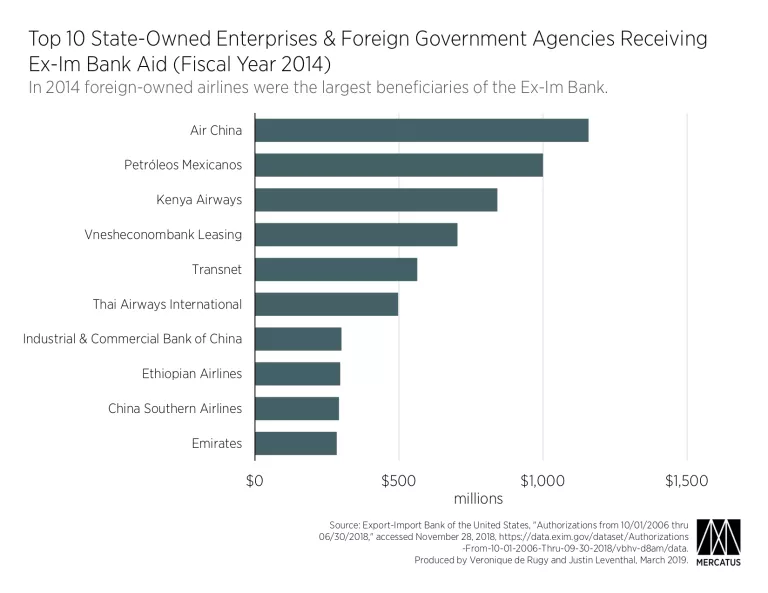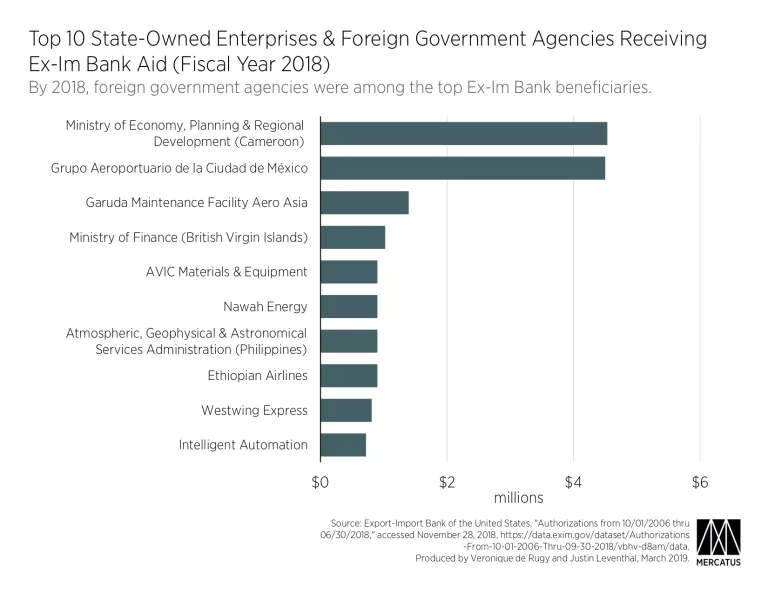- | International Freedom and Trade International Freedom and Trade
- | Data Visualizations Data Visualizations
- |
Ex-Im Bank Aid to State-Owned Businesses Falls without a Quorum
The Export Import (Ex-Im) Bank has a history of supporting companies owned by foreign governments. In 2014, the last full year the Ex-Im Bank had a quorum (that is, a sufficient number of board members to approve actions over $10 million), the top 10 state-owned companies or foreign government agencies benefiting from the Ex-Im Bank received $5.9 billion of assistance (29 percent of all Ex-Im Bank actions that year). This list was led by Air China, followed closely by Petróleos Mexicanos (Air China Limited and Air China Cargo Company Limited have been combined for this comparison).

By 2018, the most recent year without a quorum, the total amount of Ex-Im Bank loans and guarantees directed to state-owned enterprises and foreign government agencies declined by 99.7 percent, to $16.6 million. This group of beneficiaries was led by the Republic of Cameroon’s Ministry of Economy, Planning, and Regional Development (an agency of a foreign government).

Between 2014 and 2018, several notable changes occurred in addition to the 99.7 percent drop in how much financing the top 10 foreign state-financed beneficiaries received. In 2014, no foreign government agencies appeared on the list. This is in contrast to 2018, when there were three agencies of foreign governments (the Ministry of Economy, Planning, and Regional Development of Cameroon; the Ministry of Finance for the British Virgin Islands; and the Atmospheric, Geophysical, and Astronomical Services Administration of the Philippines), and one was the single top beneficiary.
The focus of the Ex-Im Bank’s largesse changed its industry focus as well, shifting away from airlines.
In 2014, Emirates airline was the 10th-largest foreign state-owned beneficiary, and 21st-largest beneficiary over all. By 2018, 246 privately owned foreign businesses were receiving more aid from the Ex-Im Bank than the 10th-largest state-owned beneficiary, which that year was the Chinese firm Intelligent Automation. Limited by its ability to provide and insure financing of only $10 million or less, a larger proportion of the Ex-Im Bank’s aid was distributed to private firms, instead of government-owned ones. This is reflected in the proportion of aid that went to the organizations on each list. In 2014 the top 10 foreign state-owned businesses received 29 percent of all Ex-Im Bank aid. By 2018 this had fallen to 0.5 percent.

This change represents nearly $6 billion of risk per year that American taxpayers are no longer exposed to as a consequence of decisions of foreign governments and the businesses those governments finance and control.
Ex-Im Bank financing to the 10 largest foreign state-owned enterprises and foreign government agencies has fallen by 99.7 percent in the period without a quorum.

